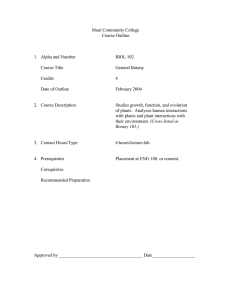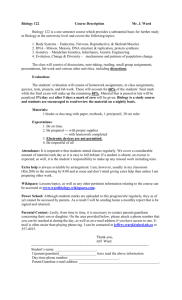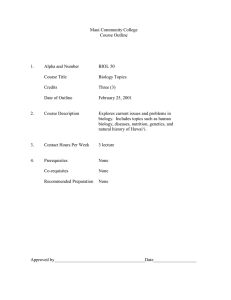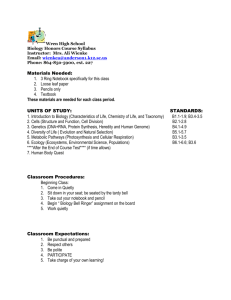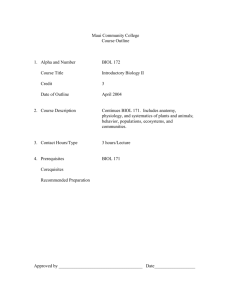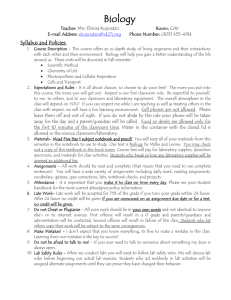SP04 - University of Hawai'i Maui College
advertisement
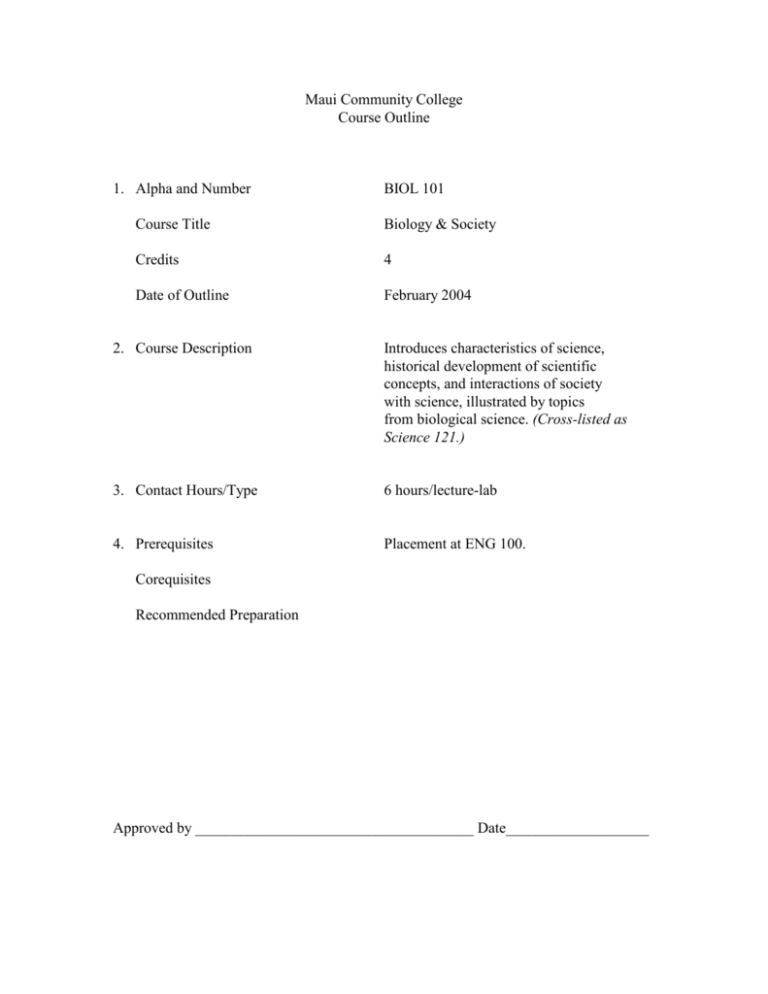
Maui Community College Course Outline 1. Alpha and Number BIOL 101 Course Title Biology & Society Credits 4 Date of Outline February 2004 2. Course Description Introduces characteristics of science, historical development of scientific concepts, and interactions of society with science, illustrated by topics from biological science. (Cross-listed as Science 121.) 3. Contact Hours/Type 6 hours/lecture-lab 4. Prerequisites Placement at ENG 100. Corequisites Recommended Preparation Approved by _____________________________________ Date___________________ 2 5. General Course Objectives Biology 101 is a general biology course for non majors. This course meets the UH community college standards for critical thinking, written communication, information retrieval and technology, and quantitative reasoning. Biology 101 fulfills the Maui Community College Natural Science laboratory requirement for the A.A. and A.S, degrees and the University of Hawai‘i at Manoa, General Education Requirements for Diversification, Natural Sciences, Biological Sciences, and Laboratory Credit (DB; 3 credits and D/Y; 1 credit). For detailed information on how Biology 101 focuses on the Maui Community College general education standards, see the attached curricular grid. This course satisfies the University of Hawai‘i at Manoa hallmarks for a Biological Natural Science laboratory course by using the laboratory methods of the biological or physical sciences; involving processes and issues of design, testing, and measurement; demonstrating the strengths and limitations of the scientific method; using the terminology of the biological sciences; involving knowledge and theories relating to processes in the biological sciences; and demonstrating inquiry that is guided by observation/experiment and reasoning/mathematics. 6. Student Learning Outcomes For assessment purposes, these are linked to #7. Recommended Course Content. On successful completion of this course, students will be able to a. design and carry out an experiment to test a hypothesis including clearing stating the question and problem, outlining materials and procedures, collecting and analyzing data; b. write an introduction, summary, conclusion, discussion of results, and an abstract of an experiment; c. explain the difference between living and non-living things; d. explain the basis of biological classification and identify and give examples of the different levels of biological organization; e. explain the basic concepts of chemistry that relate to biological systems including atoms, molecules, isotopes, ions, and simple chemical reactions; f. explain the structure of the polar, covalent water molecule and how it functions in living systems; g. describe the structure and functions of biochemical molecules including carbohydrates, lipids, proteins, and nucleic acids; 3 h. describe and explain the structure and function of various parts of prokaryotic and eukaryotic cells; i. explain and demonstrate diffusion and osmosis; j. explain and demonstrate enzyme action; k. explain how cells convert chemical-bond energy to useful energy through the process of respiration; l. demonstrate basic knowledge of the plant kingdom including structure and function of basic plant parts; m. describe variations in plant structure and function that lead to diversity based on adaptations to different habitats and pollinators; n. identify endemic and indigenous Hawaiian plants on campus; o. explain how specialized cells convert light energy to chemical-bond energy through the process of photosynthesis; p. identify the similarities and differences between the processes of respiration and photosynthesis; q. explain asexual and sexual reproductive patterns in bacteria, plants, and animals including growth and development; r. explain and give examples of a variety of different genetic patterns of inheritance; s. solve monohybrid, dihybrid, and sex-linked genetics problems; t. describe structure and functions of DNA and RNA in the inheritance of traits; u. explain the causes and effects of variations and mutations in DNA; v. describe the current methods and techniques in genetic biotechnology; w. explain the fundamentals of the theory of natural selection and competing theories of evolution; x. demonstrate basic knowledge of the animal kingdom including structure and function of basic animal systems and organs; y. identify morphological anatomical patterns and adaptations of selected animal groups; z. recognize how adaptations to different habitats leads to animal diversity; aa. demonstrate how to record and communicate objective observations of naturally occurring phenomena; bb. discuss the principles of ecology including biotic and abiotic factors, populations, communities, ecosystems, and environmental interactions; cc. demonstrate skills in the use of standard laboratory equipment and procedures including dissecting microscope, compound microscope, scientific illustration dissection, dicotomous keys, sampling techniques, chromotography, and electrophorisis; dd. demonstrate safety procedures in the biology laboratory and in the field; ee. identify current environmental problems and make hypotheses about the causes and effects; and ff. make informed decisions on biologically-related issues. 7. Recommended Course Content and Approximate Time Spent on Each Topic Linked to # 6. Student Learning Outcomes. 4 1 session Ice breaker/get acquainted activity Introduction to the course syllabus including a discussion of course materials, content, assignments, projects, servicelearning, laboratory rules, and safety 1 session and on-going Inquiry - asking, and answering questions in science (a, b) Scientific method of problem solving (a, b, cc, dd) Critical thinking in science (ee, ff) Environmental concerns and issues (ee, ff) 1-2 weeks Properties of life (c) Levels of organization in living systems (d) Basic chemistry (e, cc, dd) Properties of water (f, cc, dd) Biological chemistry (g, cc, dd) 1-3 weeks Cell structure and function (h, cc, dd) Diffusion and osmosis (i, cc, dd) 1-2 weeks Enzyme action (j, cc, dd) Respiration (k, cc, dd) 1-3 weeks Plant structure and function (l, cc, dd) Plant diversity (m, cc, dd) Endemic and indigenous Hawaiian plants (n, cc, dd) 1-2 weeks Photosynthesis (o, p, cc, dd) 1-3 weeks Mitosis and meiosis (q, cc, dd) Reproduction and development (q, cc, dd) 1-3 weeks Genetics (r, s, cc, dd) 1-2 weeks DNA & RNA (t, u, v, cc, dd) 1-2 weeks Evolution (w cc, dd) 1-2 weeks Invertebrate diversity (x, y, z, aa, cc, dd) 1-2 weeks Vertebrate diversity (x, y, z, cc, dd) 1-2 weeks Ecology (bb, cc, dd) 5 8. Text and Materials, Reference Materials, Auxiliary Materials and Content Appropriate text(s) and materials will be chosen at the time the course is offered from those currently available in the field. Examples include Biology: Concepts & Connections by Campbell, Mitchell & Reece, or any other current, up-to-date, general biology text. Laboratory manual prepared by the UH system instructors teaching the course Many books and videos are available for reference in the Biology office and in the MCC Library. Students will prepare a project using library, Internet, and community resources. Videos, personal slides, field trips, guest speakers, reference books, periodicals, internet sites, biological specimens, posters, brochures, CD-ROMs, and DVDs 9. Recommended Course Requirements and Evaluation Specific course requirements are at the discretion of the instructor at the time the course is being offered. Suggested requirements might include, but are not limited to 10 –50% Written quizzes, midterm(s) and/or a final exam covering lectures, discussions, media presentations, lab activities, field trips, guest speakers, and reading assignments 5–30% Lab skills evaluations 10 –30% Reading environmental articles and/or watching or attending programs about environmental issues in the media (including newspapers, video, magazines, journals, lectures, web-based material, etc.) and writing summaries and reactions 5–20% Reading text and other assigned materials and answering discussion questions 5–20% Participation in class discussions, group and individual oral reports 20–50% Laboratory experiments, activities, and reports 5–20% Semester projects and/or service-learning 8–10% Punctuality, attendance, and participation 6 10. Methods of Instruction Instructional methods will vary considerably with instructors. Specific methods will be at the discretion of the instructor teaching the course and might include, but are not limited to a. b. c. d. e. f. g. h. i. j. k. l. m. n. o. p. q. r. s. t. quizzes and other tests with feedback and discussion; lab practical exams on techniques and skills ; lectures including demonstrations and class discussions; experimental design and problem solving; narrated 35-mm slide and/or PowerPoint presentations; videos, DVDs, CD-ROMs with detailed viewing guide and discussion questions; lab activities including experiments, lab skill lessons, data analysis, and other activities; field trips including field notes, activities, observations, and data collection; guest speakers and attendance at public lectures; small group activities; oral reports and other student presentations; games and simulations; homework assignments such as - reading and/or watching, and writing summaries and reactions to environmental issues in the media including newspapers, broadcast television, videos, magazines, newspapers, and journals, lectures, web-based material, and other sources; - reading text and reference material and answering discussion questions; - researching environmental issues and problems; web-based assignments and activities; reflective journals; group and/ or individual research projects with reports or poster presentations; study logs and study groups; writing assignments include laboratory reports, reaction papers, summaries of current environmental issues, observations, and research notes; service-learning, community service, and/or civic engagement projects; and other contemporary learning techniques (such as problem-based learning, investigative case-based learning, co-op, internships, self-paced programs, etc.)
